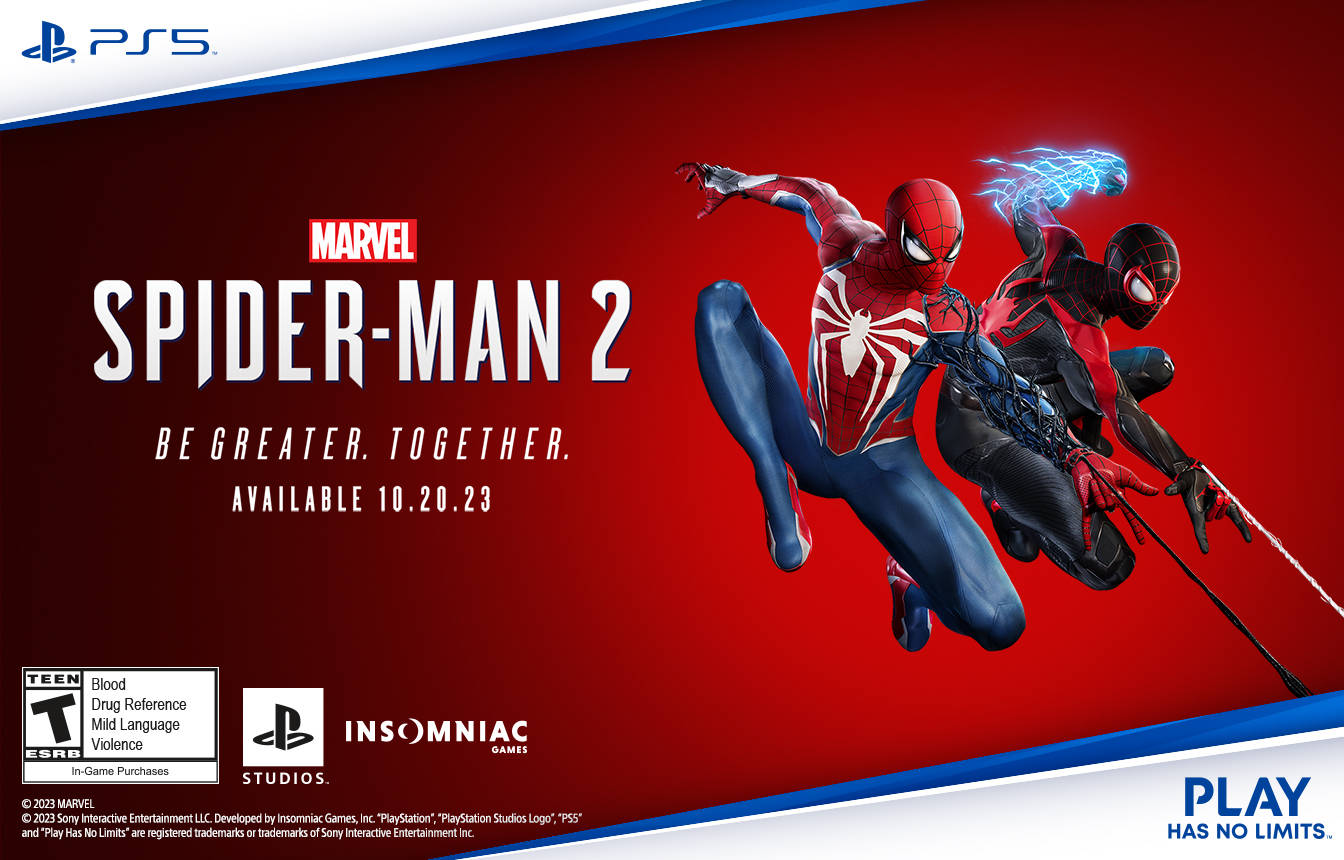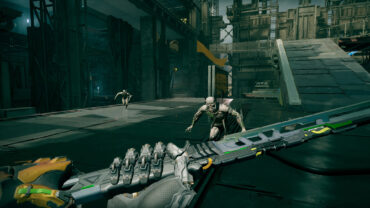It’s well past midnight. You’re in bed, glued to your phone, reading the Wikipedia entry for “rabbit.” Scrolling down the page, you decide to click on the hypertext mention of “Middle Ages.” From there, it’s another click to the historic treasure hoard of Nagyszentmiklós, and then the entry for albinism, which features an adorable photo of an albino wallaby. Eventually, you end up at “Mocha Dick,” the entry for the sperm whale that inspired Herman Melville’s most famous novel.
People make these little wiki-journeys every day, and in an age of infinite knowledge, getting lost in the world’s most famous encyclopedia is often a reward in itself. Most internet users know the feeling of falling down the wiki rabbit hole, inadvertently constructing their own narratives in the course of exploring the web. It only makes sense, then, that someone is finally making Wikipedia into a work of interactive fiction.
In 2016, writer and narrative designer Joannes Truyens decided to try fleshing out an idea he’d had since he was seventeen. This was the birth of a new hypertext project, Neurocracy, that has been taking shape over the past three years. At its core was Truyens’ idea about transmitting prion disease through fish, which grew into a world-changing fictional condition that he named Cariappa-Muren disease. “I looked at how prions actually work and let a story flow from that research,” he said. “One of the neuroscientists I’ve been chatting with is basically responsible for half the foundation of Neurocracy’s worldbuilding.” He enlisted the help of a friend, designer Matei Stanca, to design Neurocracy’s UI: a beautifully polished Wikipedia clone complete with hovering text and tooltips.
Today, Neurocracy is a hypertext fiction story set in 2049 on a fictional Wikipedia-like site called Omnipedia. Readers must explore a timeline of different Omnipedia versions to solve a murder in a dystopian world dealing with Cariappa-Murien disease, widespread biosurveillance, shared dream technology, and big data. Still in development, Neurocracy will be the first Wikipedia-style game of its kind, with Truyens planning to incorporate original multimedia and full-motion video into its final episodic form. The current excerpt, Omnipedia.app, allows visitors to sample three consecutive days on the site, each with updates and edits like the real Wikipedia. In 2017, Truyens presented an early version of Neurocracy at the AdventureX game convention in London. Last year, he quit his job at a publishing company to focus on the project full time.
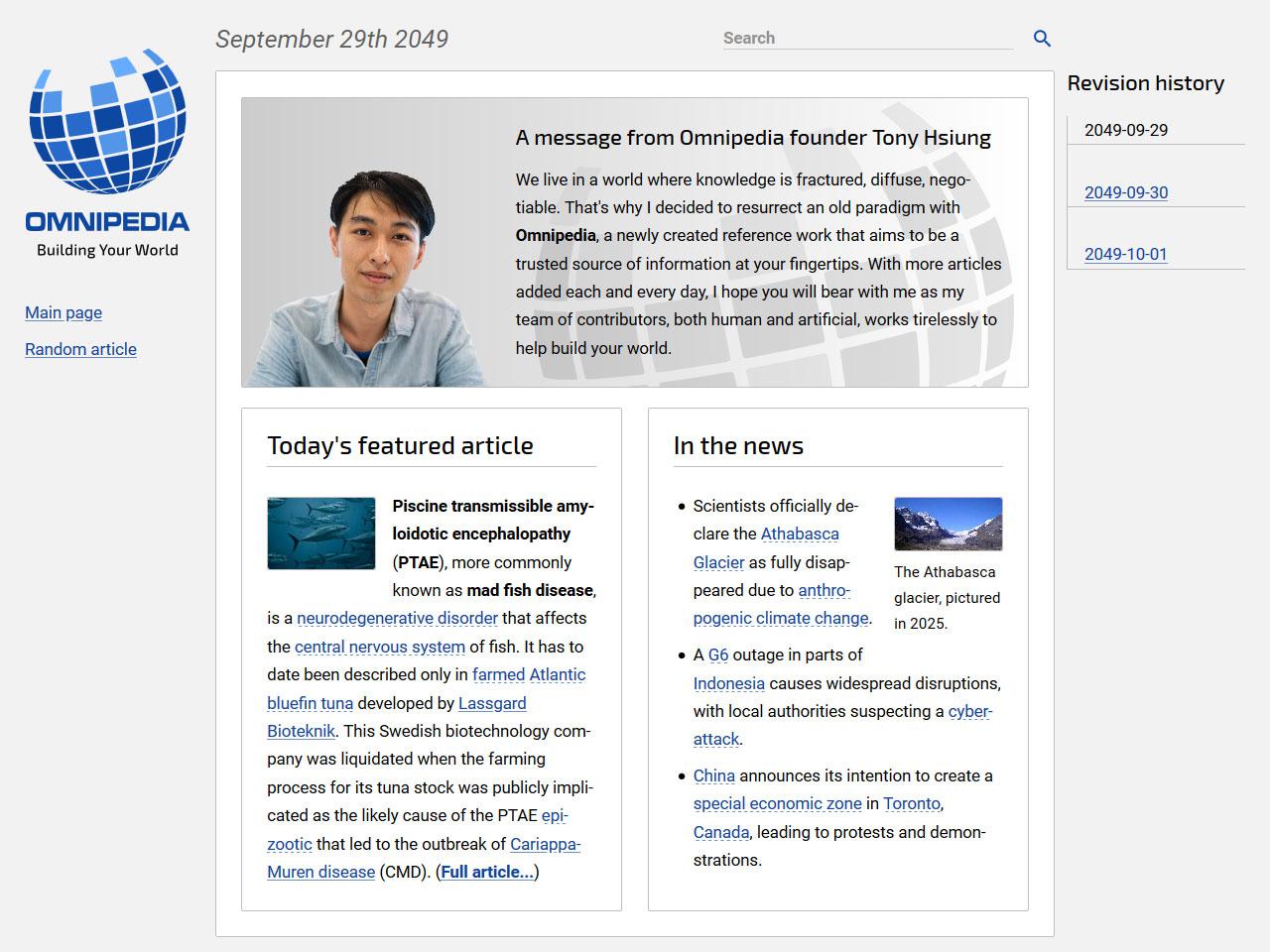
Credit: Joannes Truyens, Matei Stanca
“The elevator pitch of ‘a story told through a fictional Wikipedia’ is a strong one,” Truyens said. “People pick up on it right away and wonder why it hasn’t already been done.” And while it’s true—nobody’s attempted to make a fake Wikipedia-based murder mystery before—the project draws on a rich legacy of interactive fiction that goes back decades. (In particular, Truyens points to the original Deus Ex: “I would scour each level for datacubes, computers, kiosks, anything to read about the game’s near-future setting.”) He initially envisioned Neurocracy as a novel, but became increasingly drawn to the challenge of using Wikipedia as a format. “I believe limitations breed creativity, and committing to the idea opened up some interesting narrative avenues as well as plenty of room for ambiguity in the storytelling,” he said.
Indeed, the impulse toward building stories seems intrinsic to our species. Dr. Alex Mitchell, a professor at the National University of Singapore, researches interactive storytelling and believes it’s a natural human tendency to narrativize information. “I remember talking to my mom about this when I was a kid, because we had a set of physical encyclopedias with cross-references,” he said. “I would always follow the cross-references and keep going and going and going, and there are actually some writers who write stories like that.”
One of the first text-driven, database-style games was Portal, marketed as Activision’s first interactive novel in 1986. “With my first computer, rather grandly called an ETC 1000, I began to think of the device as an interesting platform for telling stories,” recalled Portal writer Rob Swigart. “At the time personal computers had three main functions: word processing, spreadsheets, and databases. Of the three the one that seemed most amenable to storytelling was a database—‘Spreadsheet Wars’ didn’t sound interesting.”
Moving away from the popular choose-your-own-adventure genre and MIT adventure games at the time, Swigart wanted to do something deeper, along the lines of a novel. “The games had big worlds, but very shallow,” he explained. And so Portal was born—a post-apocalyptic tale of an astronaut who returns to an empty Earth after a hundred-year voyage. The player has to figure out what happened via an old computer with a Windows-like graphical interface, aided by an AI named Homer. Portal involved a lot of reading for the time, with 450 text fragments scattered across a series of linked database sections like “Medical,” “Science,” or “Military.”
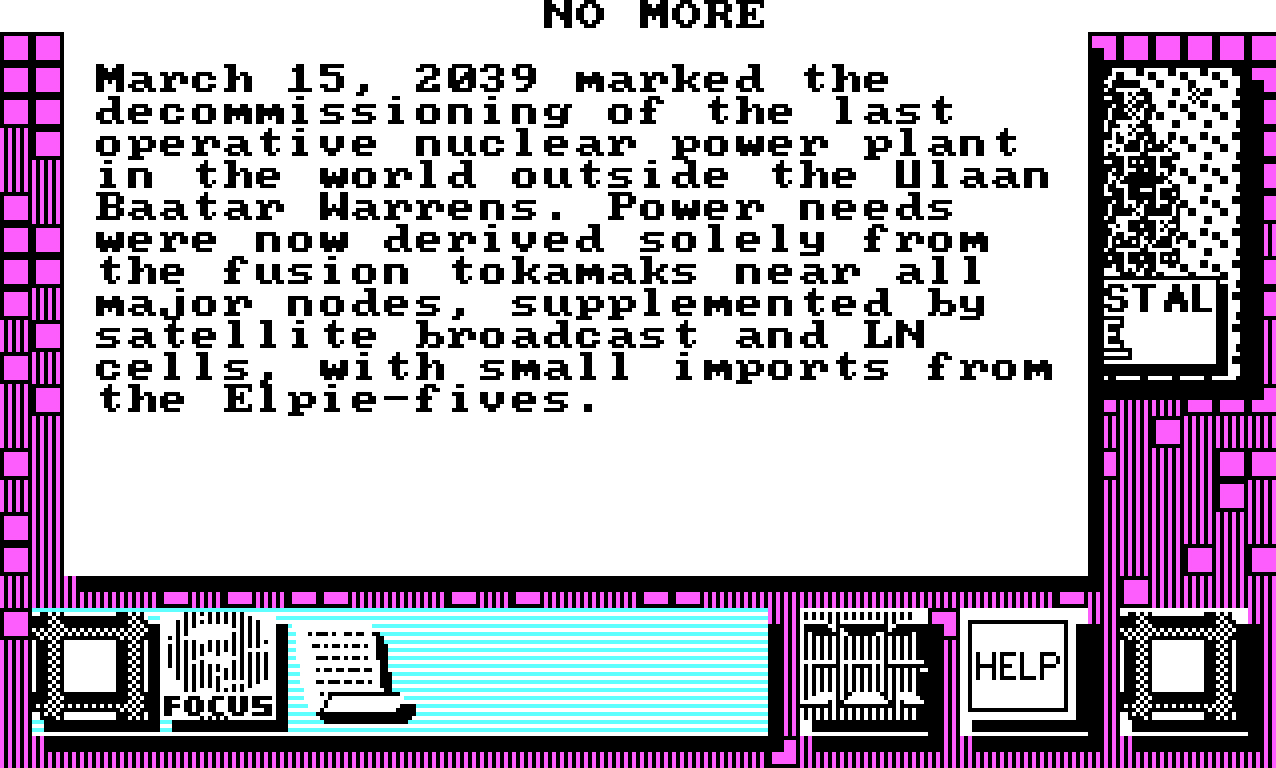
Credit: Activision
Earlier this year, Hypnospace Outlaw captured the attention of elder millenials and the Geocities generation using a similar approach to fragmented information scattered across a ’90s-style personal webpage network. Paired with lo-fi visuals and pitch-perfect writing, the indie game captured the hearts and minds of those who grew up in the cluttered, individualistic era of DIY homepages. Hypnospace offers a broader look at database-driven storytelling: Players take on the role of a corporate “Enforcer” tasked with patrolling webpages for copyright infractions, hate speech, and other illegal activity. Over time, players jump forward to newer versions of the Hypnospace network, searching for evidence to take down an elusive nemesis.
The game was a critical success, even with onerous mechanics that demanded scrupulous attention when combing through its densely-packed webpages. Hypnospace was proof that people really did want to put in the effort to beat a game full of deliberately haphazard content. Even before Hypnospace, we had indie designer Christine Love’s acclaimed visual novels Digital: A Love Story (2010) and Analogue: A Hate Story (2012), which told their stories in similar database-driven formats.
Today, we have Wikipedia, the perfect real-world model for a database-style game. “I hadn’t thought of [Wikipedia] as a game medium,” Swigart said, “but it seems a natural extension of what Portal was, or could have been if the technology were more developed at the time.”
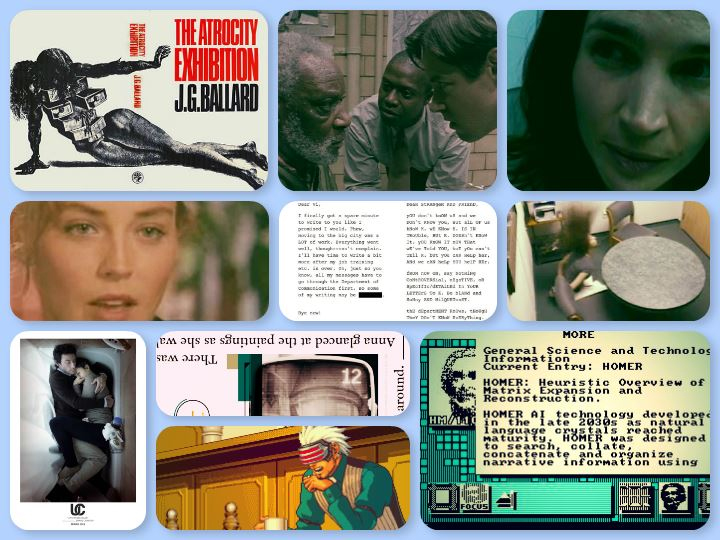
Courtesy Sam Barlow
Portal has had a formative impact on such games of today, including Sam Barlow’s award-winning interactive game Her Story. For Barlow, Portal was something truly singular: “a glimpse into an alternate future of video games that we’d skipped over,” he said. The game appeared on one of Her Story’s early moodboards, alongside J.G. Ballard’s The Atrocity Exhibition, an experimental novel divided into short, interlinked story chapters.
“The breadth of story info and the sense of exploring, uncovering a human story through this clunky computer felt like a lot of what I wanted out of my game,” Barlow said of his experience with Portal. “I didn’t play it when it was first released, but I’d maybe seen it on one of the abandonware sites later, and when I was early into developing Her Story I did this survey of all the ‘interface games’ I remembered… Fourth Protocol, Vera Cruz, Hacker. And I pulled up Portal and—wow. I devoured it.”
Neurocracy isn’t the first interactive fiction project to use the Wikipedia format, but so far, it’s the most developed. In 2017, Jonny Muir released Unit 322 (Disambiguation), a Twine-powered minigame styled as a disambiguated Wikipedia entry where players explored links associated with the term “Unit 322.” After scouring the “site” and its footnotes, players unlocked hidden codes that allowed them to solve a gruesome murder. That same year, Unit 322 was nominated for a XYZZY award for “Best Use of Innovation.” On the game’s Interactive Fiction Database page, one reviewer described it as a blend of creepypasta, Wikipedia, and detective work that revealed a much greater world beyond its handful of pages. It took less than half an hour to complete, but Unit 322 proved to be a concise, if not grim example of just how well Wikipedia can be harnessed as a piece of interactive fiction.
Truyens reached out to Muir to ensure he wasn’t stepping on any toes (he wasn’t—Muir “loved” the idea of Neurocracy), and in turn, Muir pointed him to the SCP Foundation, a collaborative writing project styled as a Wikipedia community. SCP stands for “Serve, Contain, and Protect,” and chronicles the acquisition and containment of fictional SCPs or “skip” objects with supernatural powers, with the vast repository of SCP writing covering everything from Lovecraftian horror to urban fantasy. One of its best-known objects is SCP-3008, a disturbed IKEA furniture store that never ends, which turned into a fan-made game project; the same developer, Thaumiel Games, is also working on a side project about SCP-450, a death row cell block in a federal prison.
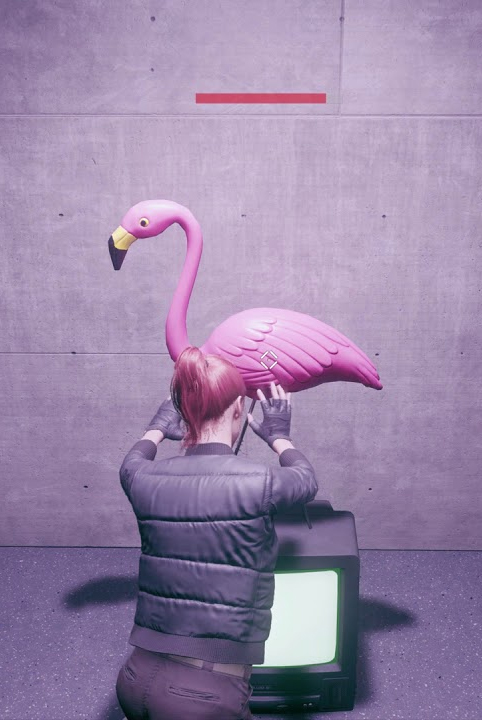
Credit: Remedy Entertainment, 505 Games
If this concept sounds vaguely familiar, it’s because SCP was a major source of inspiration for Remedy Entertainment’s surprise hit Control, which borrows the same idea of a shadowy organization tasked with keeping supernatural objects under, well, control. Since 2007, when it first materialized on 4chan, SCP has grown into an enormously creative crowdsourced work of fiction, steered by a small army of moderators, dedicated lore experts and editors who maintain the quality and integrity of the community. Besides the wiki-style entries—written in the same dry, matter-of-fact tone as encyclopedia pages—the site also has “Foundation Tales,” which are short stories about SCP phenomena. For instance, a tale titled “October 15th, 2012” concerns SCP-2845, a mysterious antlered entity that can change its form at will. Another, “Claw And Order,” refers to SCP-2501, a mechanical gauntlet linked to the fictional mega-corp of Marshall, Carter and Dark, which plays a big part in SCP lore.
Navigating the world of SCP isn’t a game, but it taps into what Dr. Mitchell calls a gameful text. Gamefulness is a concept far removed from one of tech’s favorite words: gamification. The latter implies a mechanical approach to making an activity into a game, such as learning a new language, chores, or even exercise. On the other hand, gamefulness involves a sense of play and free movement—the sort of movement mirrored in the way we might explore a wiki-site to learn more about a topic. Understanding Wikipedia games is an exercise in learning to interact with text and narratives in the same way one might approach a more traditional graphical game. This might seem challenging, given the density of large, daunting chunks of text in a post–“pivot to video” world. But hypertext has been around for decades, and Dr. Mitchell believes that it’s actually become more relevant to the modern lifestyle.
“One of the controversies about hypertext is that it was only a bunch of academics who ever really enjoyed it.” he said. “It’s an interesting form because it is inherently fragmentary.” Like any video game, a player/reader has to put work into a hypertext game, which is an example of an ergodic text, or a text that demands effort. “We have more skills these days to put those things together because our world is so complex and fragmented,” said Dr. Mitchell, pointing to Twitter, episodic platforms like Netflix, and Snapchat, where we’re forced to pay attention. “I think that that that we’re becoming more used to that kind of storytelling.”
One of Truyens’ early pieces of feedback was that although Neurocracy isn’t interactive in the same way as other text-based games, it still feels interactive. “You don’t guide the story with overt dialogue options or actions, but piece it together yourself based on the information found in the various articles,” said Truyens, paraphrasing the tagline for a Kickstarter visual novel that inspired his approach: “A book you can play, a game you can read.”
Unlike its traditional game peers, Neurocracy doesn’t present the player with an adversary or a charismatic AI to guide them through the story. It’s essentially an experience that a lone player has on their own, and Truyens hopes that Omnipedia users will seek out others to discuss and debate their interpretations of the story. “It’s on me to to thread a particularly ambiguous line where the story of Neurocracy is yours alone, because you tell it to yourself,” he said. By allowing the player to go spelunking for information at their leisure, Truyens allows them to make the world in Omnipedia become real.
Of course, playing with reality also has drawbacks. In the case of 2014’s ALFA-ARKIV, some overzealous players can get excessively into conspiracy mode. Part alternate reality game, part interactive fiction project, ALFA-ARKIV took a slow burn approach that embroiled players in the search for Junko Junsui, a strange Russian woman involved with a terrorist group. In 2009, a Facebook profile for Junko appeared, and over the years, more strategically placed information seeped out into the open, including a Change.org petition and even a page on Wikileaks (all of which have been taken down). Finally, in 2014, ALFA-ARKIV appeared in the form of an iPad app, filled with videos, letters, government documents, and ominous-looking data. By then, conspiracy theorists were gunning for answers, which created headaches for ALFA-ARKIV’s original creators, writer Rob Auten (Gears of War: Judgment, The Vanishing of Ethan Carter) and Patrick Marckesano. And because we can’t have nice things, some Junsui enthusiasts eventually turned to stalking and doxxing.
Truyens isn’t taking the viral route, which is probably for the best; a fake Wikipedia from the future would be hard to pull off, even in the age of deepfakes and clickbait. The 2049 date emblazoned atop Omnipedia’s landing page is a big, clear blessing—the “Athabasca Glacier” mentioned in the news section is a real geographical feature. Even with just eight articles, the current Omnipedia excerpt is an excellent facsimile of the world’s most popular informational resource, down to the writing tone. “It’s meant to be this dry, curated encyclopedia, even when you’re reading a harrowing account of a World War II battle. I’ve always found that to be an interesting juxtaposition, which I embraced for Neurocracy,” Truyens said, reflecting on the medium. “People have been getting back to me saying they felt terrified by this dystopian nightmare communicated in such a dispassionate tone.”
Nonetheless, Wikipedia’s very human community can get extremely passionate about edit warring. Editors must follow strict protocols when dealing with disputes, reversions, and “tendenitious editing.” In the site’s earlier days, Sam Barlow experienced wiki-drama first-hand while attempting to write a few Wikipedia entries; today, like billions around the world, he sees the site as an indicator of legitimacy. “If something doesn’t have a Wikipedia article, it feels less important,” he said, a sentiment likely shared by most people who use the internet in 2019.
These built-in conflicts lend themselves well to gameful writing, and Truyens plans to sprinkle these contentious bits of Wikipedia culture throughout Neurocracy, and perhaps even put in an Omnipedia discussion forum. “One of the articles I’m planning to write for Omnipedia is one on itself, on Omnipedia,” he revealed. “That article will serve as a cheeky tutorial, but it will also explain how the crowdsourcing aspect of the site works and what effect it has on how the information is collated.” Truyens is also considering adding more game-like elements to Neurocracy, including a site tracker powered by an algorithm to keep track of the reader’s activity on Omnipedia.
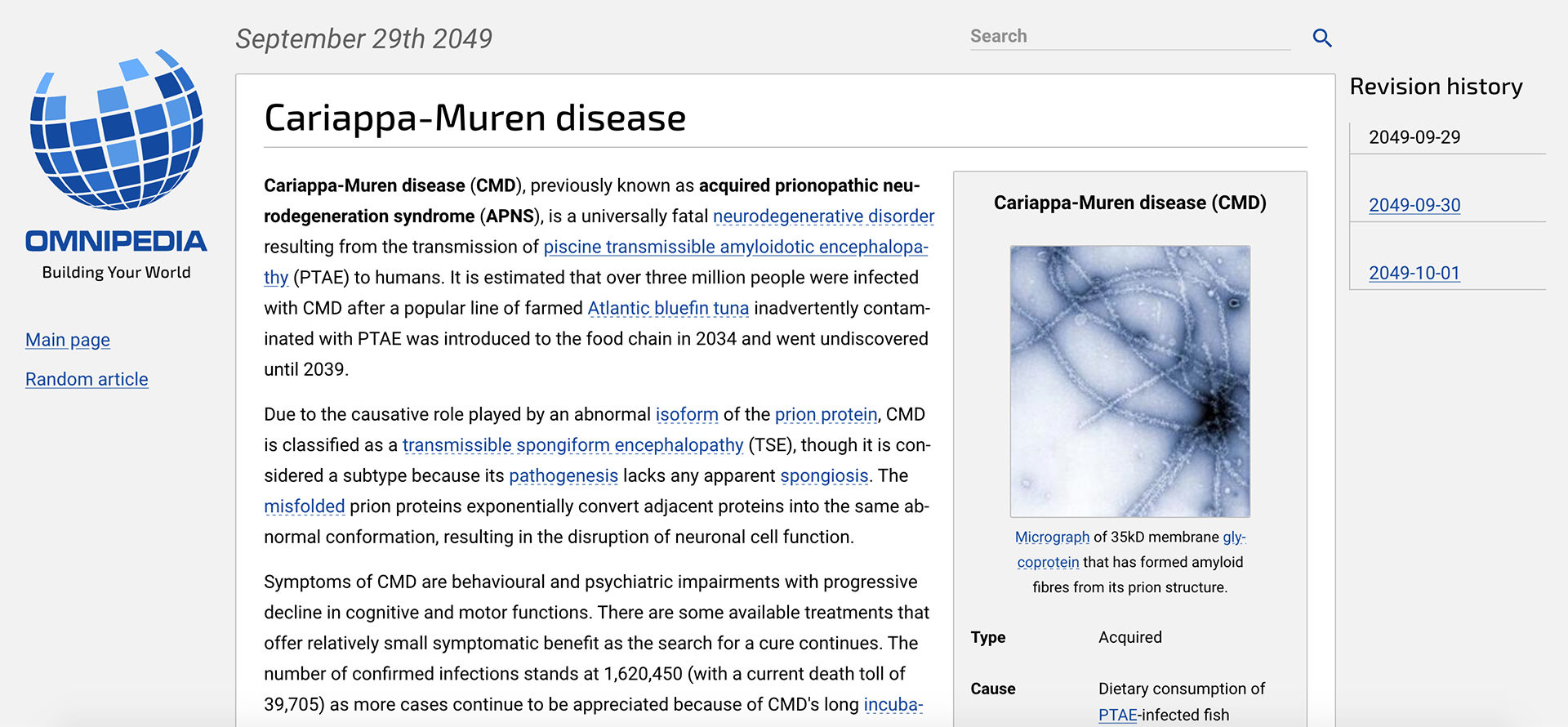
Credit: Joannes Truyens, Matei Stanca
Right now, Truyens is in the process of pitching Neurocracy to studios and publishers, which he admits has been a little tricky. “It would be handier if Neurocracy fell into a specific category. The feedback I’ve gotten so far tells me that there are a bunch of different audience engagements and takeaways. Some see it as a detective novel, others as a puzzle game.” He’s planning to expand the Omnipedia universe to 40 or 50 articles, which will change over the course of 10 days in 2049. The goal is to launch the game—with live-action video, diagrams, maps, and other audiovisual material—in 2020.
Game or not, diving into Neurocracy is a distinctly gameful experience, and pedants shouldn’t dismiss the wiki medium as a new way to tell stories. “There are papers about the definition of games and listing like 20 or 30 different definitions and tearing them apart,” Dr. Mitchell said. “If the basic idea of a game is this deliberately difficult situation you’ve put yourself into… you have goals, you’ve got obstacles to overcome that are deliberately difficult because that’s what you want to be doing, and there’s maybe some sort of winning condition, then I think [Neurocracy] fits most of that.”
The power of Neurocracy lies in its effectiveness as an alternate reality story, and its chosen disguise as an encyclopedia is a meta-nod to our current struggle with the news. “When we go to a movie, we see visuals that are heightened. When we read a book, we are given a beautiful cover and careful typesetting and highly worked prose,” Barlow said. “There’s a sense that this is valuable content. How do you get the audience to dig in, to value what you’ve made, if it looks like something we’ve come to think of as almost ubiquitous and free?”
Come 2020, Truyens and Stanca’s ambitious brainchild will be the first of its kind, and it most certainly won’t be the last.

Alexis is a freelance journalist based in Singapore. She has a soft spot for abandonware and old point and click games, and once tried to set up a bot shop in Diablo 2—sorry, Blizzard. She lives on Twitter at @steppinlazer.


